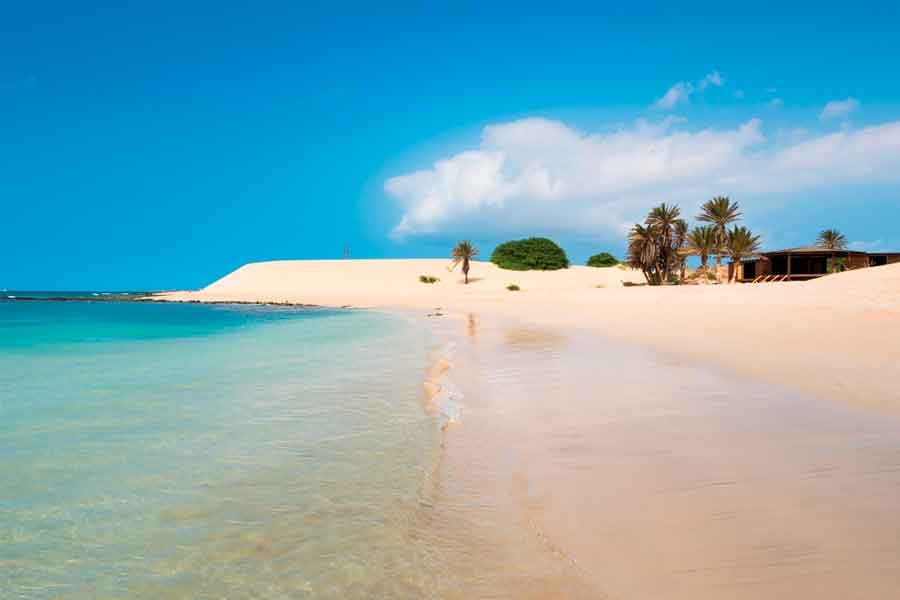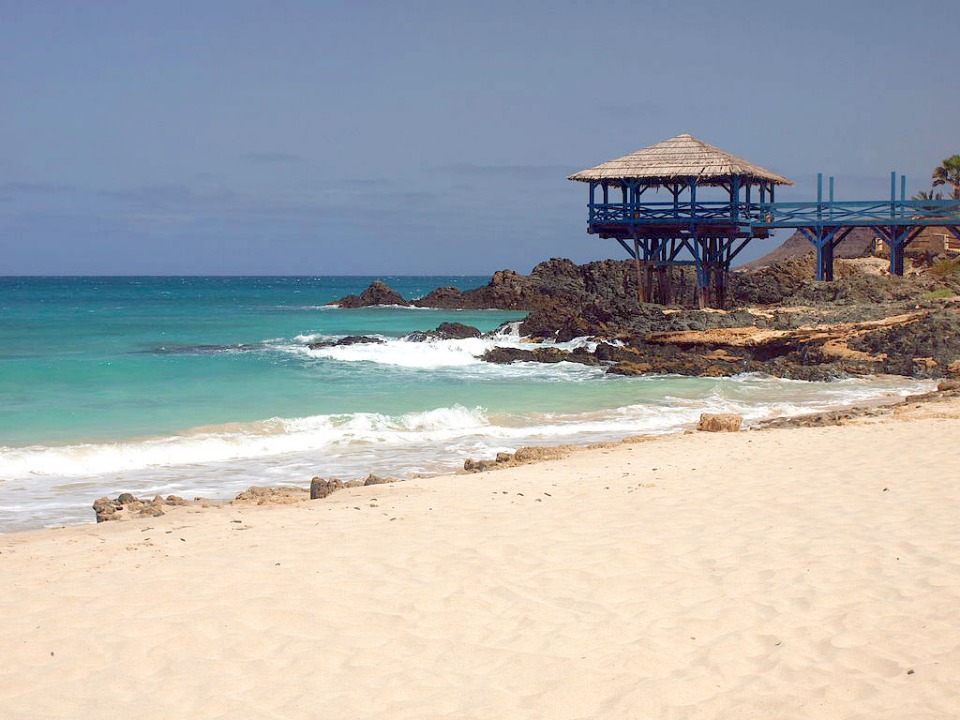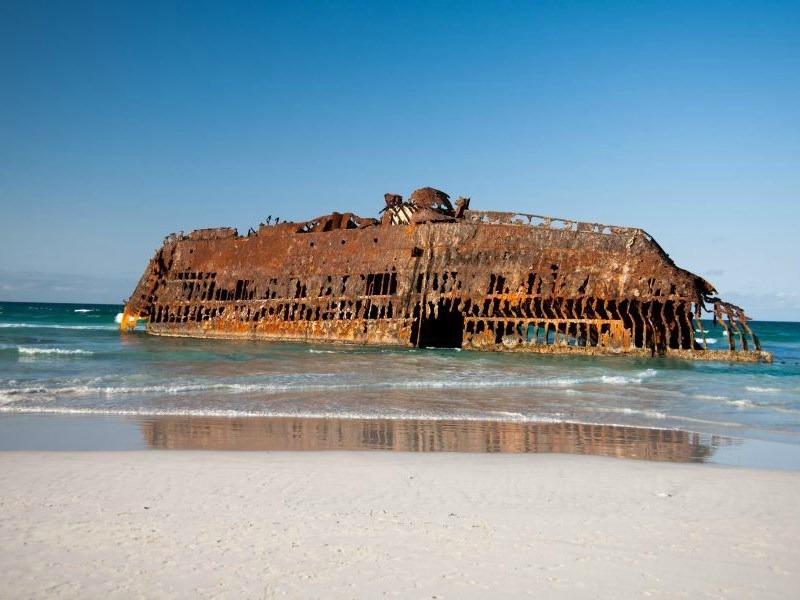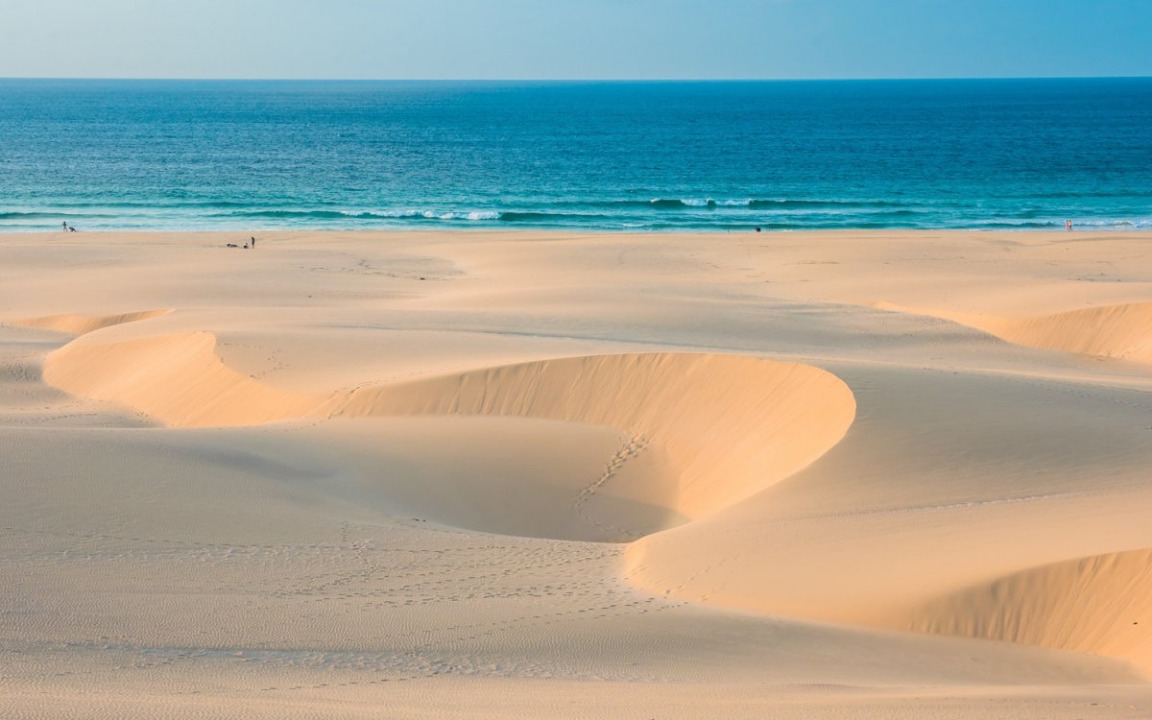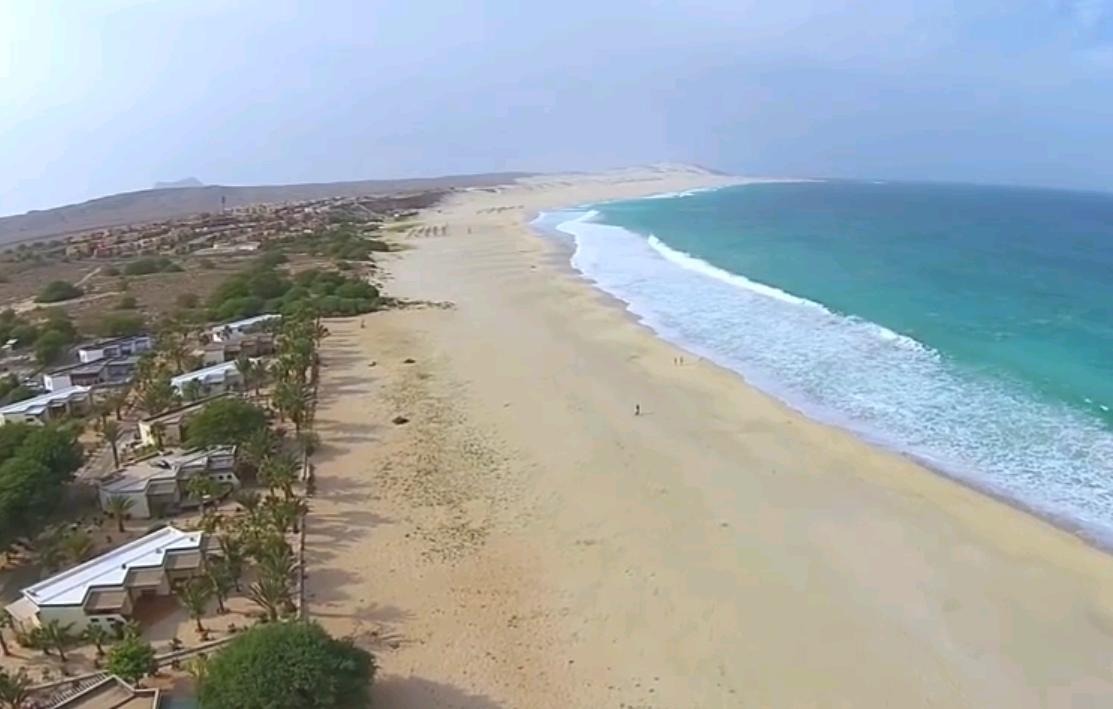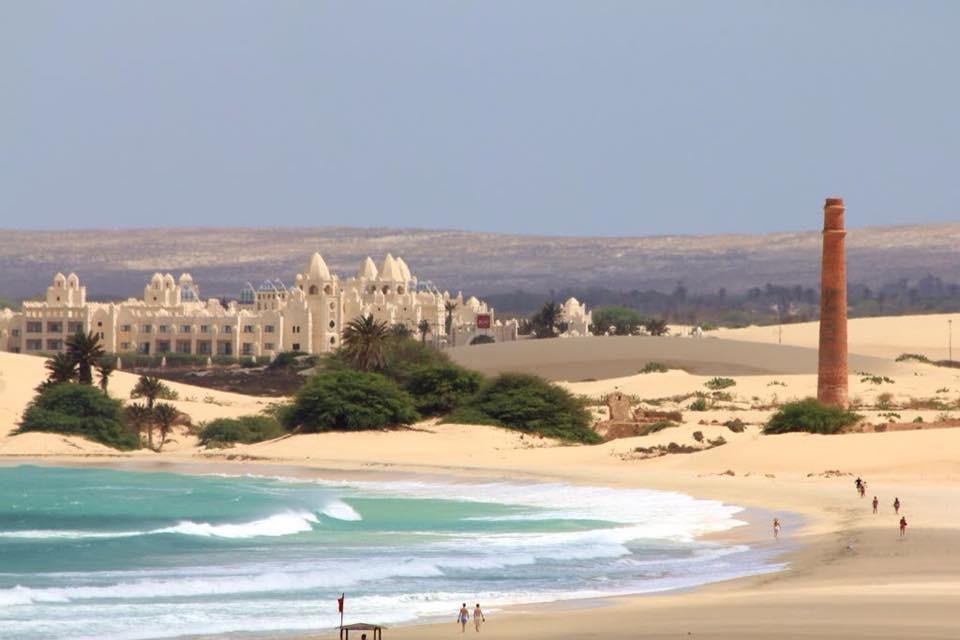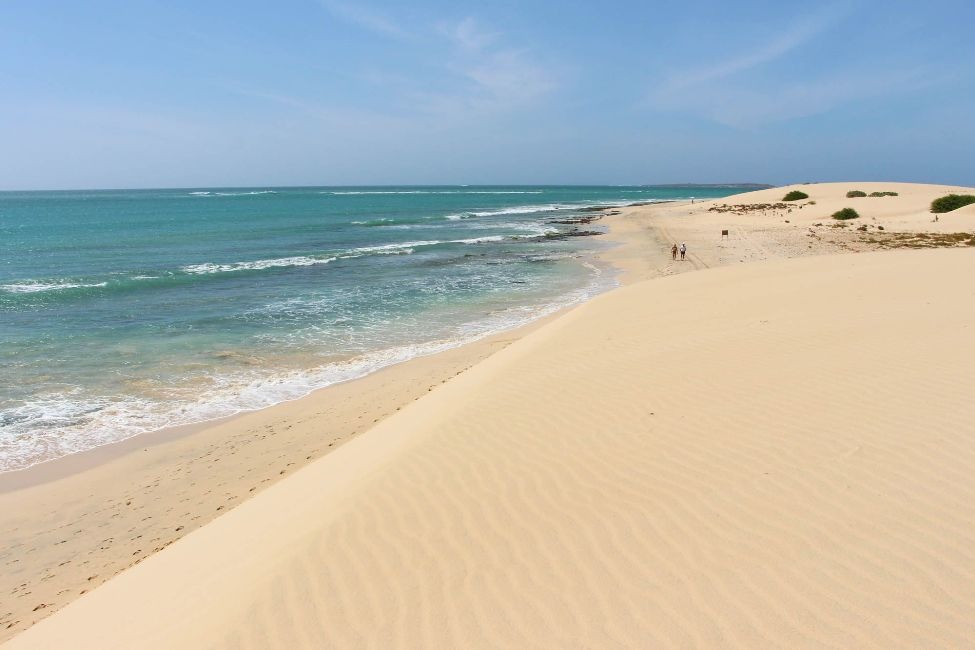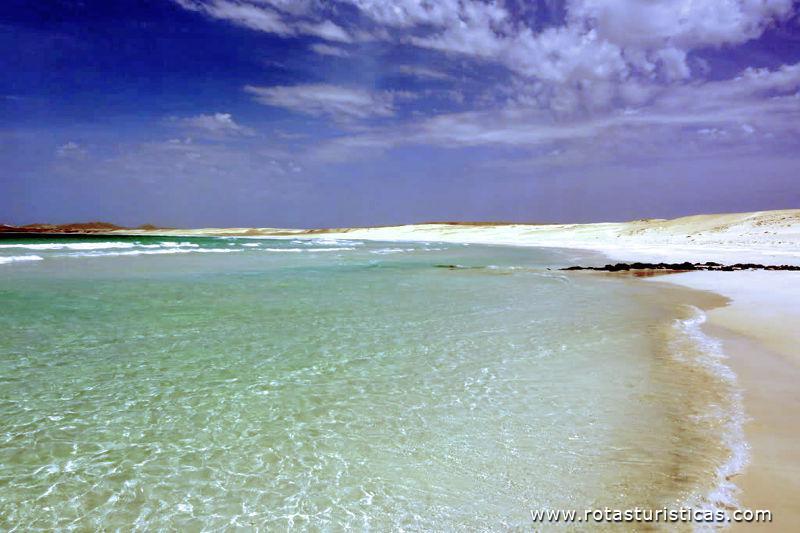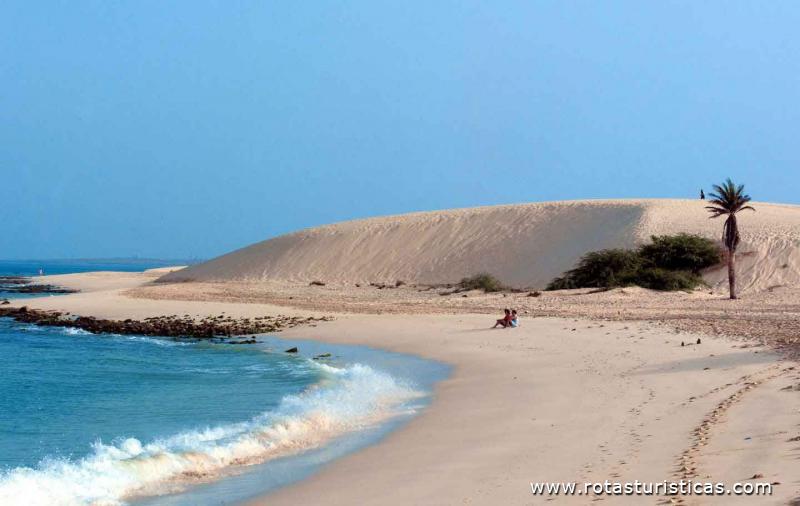Pictures of: Boavista Island - Cape Verde
Location map
Airports
Hotels and other Accommodation
Where to Eat
World Nomads
The Travel Insurance with the largest coverage

The Travel Insurance with the largest coverage

Boavista Island
Being the island of the archipelago closest to the African continent has the climate and the landscape markedly influenced by the dry and hot winds of the Sahara.
With an area of 622 km2, the third largest island of Cape Verde presents an extremely flat relief of sedimentary rocks with eruptive outcrops in certain areas.
Island of the dunes and the morna, paradisiacal and tropical, of singular beauty, where they reign the long sandy beaches that kiss the blue-green sea of tepid waters, all year round, it is in essence an island of warm people who know how to receive those who want live there a season of discovery and rest.
The highest point is the Pico d'Estancia with 390 meters. To the north and west of the island the landscape is somewhat surprising by the extensive sand dunes that along with several oases of date palm trees and coconut trees forming a desert scenery such as the Viana Desert.
A small Jewish cemetery, next to a brand new Hotel on Cruz beach, is a precious relic, a testimony of the Jewish community that settled here. In Rabil, the nearest town to the airport and the old seat of the county, the old Mother Church of S. Roque, the first of the island, built in 1801, can be admired. As a curiosity, Rabil is also the name by which it is known on this island the "frigate", characteristic marine bird of the archipelago and in danger of extinction. Another reason to visit this place is the ceramics factory-school where it is intended to preserve the well-known local pieces, whose work uses markedly African root methods. Between this village and Estância de Baixo there is a valley rich in vegetation where coconut trees and palm trees predominate. The landscape of this area is due to the existence of a vast hydrographic basin, considered as one of the largest in Cape Verde, even if the water runs only in short periods during the rainy season; half-walled with this demonstration of fertility surprises the Viana Desert, which is a small Sahara, recalling the continental origins of the dry and arid climate that characterizes the archipelago. However, the most picturesque villages are the northern agricultural towns, João Galego, Fundo de Figueiras and Cabeça de Tarafes, as far as Ervatão Beach, a protected area where red turtles are spawned in spring / summer.
With an area of 622 km2, the third largest island of Cape Verde presents an extremely flat relief of sedimentary rocks with eruptive outcrops in certain areas.
Island of the dunes and the morna, paradisiacal and tropical, of singular beauty, where they reign the long sandy beaches that kiss the blue-green sea of tepid waters, all year round, it is in essence an island of warm people who know how to receive those who want live there a season of discovery and rest.
The highest point is the Pico d'Estancia with 390 meters. To the north and west of the island the landscape is somewhat surprising by the extensive sand dunes that along with several oases of date palm trees and coconut trees forming a desert scenery such as the Viana Desert.
A small Jewish cemetery, next to a brand new Hotel on Cruz beach, is a precious relic, a testimony of the Jewish community that settled here. In Rabil, the nearest town to the airport and the old seat of the county, the old Mother Church of S. Roque, the first of the island, built in 1801, can be admired. As a curiosity, Rabil is also the name by which it is known on this island the "frigate", characteristic marine bird of the archipelago and in danger of extinction. Another reason to visit this place is the ceramics factory-school where it is intended to preserve the well-known local pieces, whose work uses markedly African root methods. Between this village and Estância de Baixo there is a valley rich in vegetation where coconut trees and palm trees predominate. The landscape of this area is due to the existence of a vast hydrographic basin, considered as one of the largest in Cape Verde, even if the water runs only in short periods during the rainy season; half-walled with this demonstration of fertility surprises the Viana Desert, which is a small Sahara, recalling the continental origins of the dry and arid climate that characterizes the archipelago. However, the most picturesque villages are the northern agricultural towns, João Galego, Fundo de Figueiras and Cabeça de Tarafes, as far as Ervatão Beach, a protected area where red turtles are spawned in spring / summer.
Tourism
Beautiful and extensive beaches make this island, still to be discovered, the ideal place for lovers of "sun and sea", deep diving and fishing.
The outline of the Boavista is designed by a perfect semi-desert environment, extensive and lonely white sand beaches, topped by a sea of crystalline turquoise that result in fantastic beaches that extend for 50 km around the island.
Departing from the main locality, Salrei, you will find the smaller beaches of Estoril and Cascais. To the south extend the immense beaches that define the future of this island. The beaches of Chaves, where the ruins of the old Ceramic Factory, Varandinha, Curralinho and Santa Monica still stand, will in future be bathing areas of international projection.
In this crossing, here and there, large expanses of luxuriant vegetation, full of coconut palms, corn and pastures, were not this island that holds the largest underground water basin in the entire archipelago.
Its new international airport, the Rabil-Lacacão structuring road and the sea port, make Boavista one of the islands with the greatest potential for the development of Turismo de Mar, as it offers excellent conditions for water sports such as windsurfing ", Diving, deep sea fishing, where you can find a wide variety of fish, and deep-sea fishing. The possibilities of lodging, once scarce and compensated by the hospitality of the caretakers, will tend to increase rapidly and considerably by the construction of hotel units and tourist villages.
In another direction, inland, across the North Valley, the interior landscape is desert. There are small villages where their inhabitants, in a constant struggle against the scarcity of water, persist in maintaining the activity that was the first one of the island: the cattle raising. In the rainy season the well-known Boavista goat cheese is made. In the course of 2 hours crossing the towns of João Galego, Fundo das Figueiras and Cabeça dos Tarafes, you reach Ervatão beach, a protected area where red tartugas are sprinkled in the spring / summer.
Boavista should be considered not only for its bathing wonders but also for its islets and zones of great variety and landscape, fauna and botanical value, interesting aspects for a diversity of lovers.
On a tour of the island, in the village of Sal Rei, we are faced with evident signs of a rich past where European architecture prevailed. The remains of the salt mines of the XVII, main source of the economy of the time, also translate the golden period that the island reached in the past. In front of the village, we can admire the ruins of the old fort Duque de Bragança that rests on a small island, bathed by waters rich in marine fauna and underwater views highly appreciated by divers.
The outline of the Boavista is designed by a perfect semi-desert environment, extensive and lonely white sand beaches, topped by a sea of crystalline turquoise that result in fantastic beaches that extend for 50 km around the island.
Departing from the main locality, Salrei, you will find the smaller beaches of Estoril and Cascais. To the south extend the immense beaches that define the future of this island. The beaches of Chaves, where the ruins of the old Ceramic Factory, Varandinha, Curralinho and Santa Monica still stand, will in future be bathing areas of international projection.
In this crossing, here and there, large expanses of luxuriant vegetation, full of coconut palms, corn and pastures, were not this island that holds the largest underground water basin in the entire archipelago.
Its new international airport, the Rabil-Lacacão structuring road and the sea port, make Boavista one of the islands with the greatest potential for the development of Turismo de Mar, as it offers excellent conditions for water sports such as windsurfing ", Diving, deep sea fishing, where you can find a wide variety of fish, and deep-sea fishing. The possibilities of lodging, once scarce and compensated by the hospitality of the caretakers, will tend to increase rapidly and considerably by the construction of hotel units and tourist villages.
In another direction, inland, across the North Valley, the interior landscape is desert. There are small villages where their inhabitants, in a constant struggle against the scarcity of water, persist in maintaining the activity that was the first one of the island: the cattle raising. In the rainy season the well-known Boavista goat cheese is made. In the course of 2 hours crossing the towns of João Galego, Fundo das Figueiras and Cabeça dos Tarafes, you reach Ervatão beach, a protected area where red tartugas are sprinkled in the spring / summer.
Boavista should be considered not only for its bathing wonders but also for its islets and zones of great variety and landscape, fauna and botanical value, interesting aspects for a diversity of lovers.
On a tour of the island, in the village of Sal Rei, we are faced with evident signs of a rich past where European architecture prevailed. The remains of the salt mines of the XVII, main source of the economy of the time, also translate the golden period that the island reached in the past. In front of the village, we can admire the ruins of the old fort Duque de Bragança that rests on a small island, bathed by waters rich in marine fauna and underwater views highly appreciated by divers.
Gastronomy
The cuisine of this island is closely linked to the main activities of the population - fishing, which translates into wonderful typical dishes based on fresh fish and seafood, and the raising of cattle (goats) that give rise to the well-known cheese traditionally accompanied with sweet of papayas. Together they are a great delicacy.
The local gastronomic specialty is the "Botchada".
The local gastronomic specialty is the "Botchada".
Weather
Tropical dry, with temperatures around 25ºC during most of the year.
Other tourist destinations in:
Cape Verde
Cape Verde
Other world tourist destinations
Why to book with BOOK HOTEL OPORTO
The best prices
Our partnerships with the world´s largest operators offer research on the best market prices.
More options
At Rotas Turisticos you can book the hotel, buy the air ticket, book the transfer from the airport to the hotel and vice versa, book the local excursions, rent the car, take travel insurance and consult the places to visit and where to go.
Holiday Tips & Destinations
Hundreds of holiday destinations with all the options that allow you to easily choose the destination that best suits your dream vacation.
BOOK HOTEL OPORTO
Links

